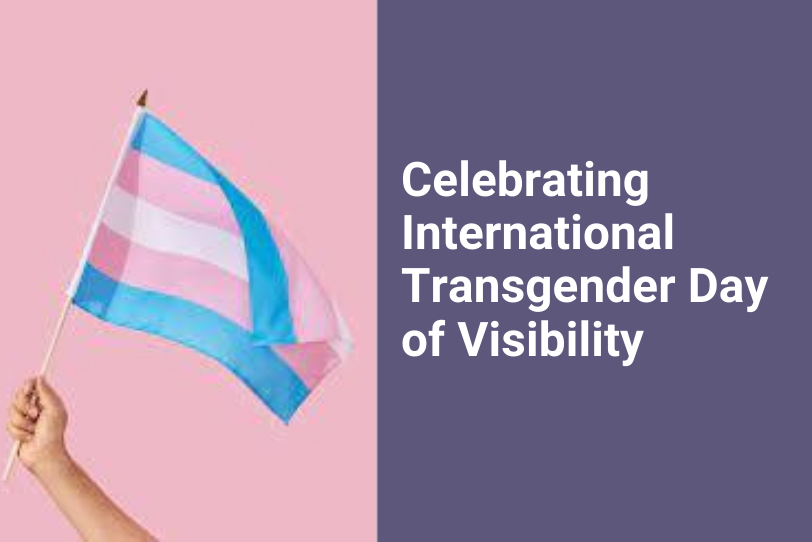
Celebrating International Transgender Day of Visibility
March 31st is the International Transgender Day of Visibility, and an extremely important opportunity for us to bring light to the issues and struggles faced by the trans community. How can you contribute? Get educated! With a better understanding and knowledge of the trans community, we can help lessen the challenges they face each and every day.
Let’s Start With the Basics
Very simply, individuals who are transgender have a gender identity that is different from the sex assigned to them at birth. It’s an easy concept, but too many people are ignorant or unwilling to understand what this means for transgender people.
Right now there are more than 2 million transgender individuals living in the United States alone, from all different racial, ethnic, and religious backgrounds. They are mothers, fathers, daughters, sons, coworkers, neighbors, and contributing members of society.
There is tremendous diversity in the trans community. Some may identify as trans women or trans men, but there are also trans individuals who identify as non-binary, genderqueer, gender non-conforming, bigender, agender, or another identity that is in line with their personal feelings and experiences.
Challenges Faced by the Transgender Community
Transgender individuals struggle with obtaining basic human rights to an enormous degree, in addition to dealing with higher than average difficulties in their personal lives. Here are some facts by the numbers:
- 1 in 5 transgender people have experienced homelessness at some point in their lives
- 50% of transgender people have been assaulted by a romantic partner
- Transgenger people of color are 6 times more likely to experience violence during police interactions than white cisgender individuals
- 1 in 8 transgender people have been evicted on the basis of being transgender
- 41% of trans people have attempted suicide
- 1 in 5 transgender people have reported that they are unable to get the medical care they need
These numbers are staggering, considering how much education is now available about the transgender community and what it means to be trans. Society is not working hard enough to protect people in the trans community, and this needs to change–that’s why the International Trans Day of Visibility is such an important event and one that everyone needs to be aware of.
How Can I Be a Trans Ally?
Being a trans ally is extremely simple, and it boils down to one basic element: respect. Having respect for people’s differences, preferences, and the right to live their authentic lives. Here are some simple ways to be supportive of the trans community.
Have a question? Just ask!
It’s normal to be unsure of how to respectfully interact with trans people, but if you’re worried about being offensive, just ask! Questions like, “What are your preferred pronouns?” show that you want the person to be comfortable and feel respected. On the flip side, there are some questions that you should never ask. Questions like, “But are you really a man or a woman?” are insensitive and devaluing and should never be asked. A person’s sex is not their gender, and it’s also no one’s business. If a person identifies as a woman, uses female pronouns, and presents as a woman, then they are a woman. That’s it.
Respect often boils down to having common sense. Questions referring to someone’s “real” anything (what’s your real sex, what’s your real name, etc.) are offensive and not relevant to your interactions with that person. Always ask yourself, “Do I need this information in order to engage with this person?” Preferences, however, are different and you should feel free and comfortable asking for guidance on how you can respectfully engage with a trans person.
*A note on pronouns: there may be times when you inadvertently use the wrong pronouns for a trans person. Should this happen, don’t panic, but also don’t let it slide. Apologize for misspeaking and assure them that you will do better moving forward. Being addressed by the correct pronouns is extremely important to everyone, and trans people are no exception. Acknowledge your error and be mindful not to make the same mistake twice. Again, if you’re not sure of someone’s pronouns, just ask!
Listen
Coming out as trans can be a difficult experience. If someone you know comes out to you as trans, it may come as a shock, but the most important thing to remember is that this person is telling you based on trust. Accept it as you would any private knowledge — assure them that you hear them, you are listening to them, and you are there to support them in any way that they need. Transgender people face so much adversity from society as a whole, the people closest to them should be a safe haven.
Be Supportive
Don’t leave it to trans people to fight transphobia alone. If you see it happening, do what you can to help combat it. It is everyone’s responsibility to respond to injustice when we see it happening. Don’t stand by. Be an active advocate.
Fight Back Against Harmful Language
There is a great deal of harmful verbiage toward trans people and even ‘innocent’ remarks can do damage. Words are very powerful, and making a comment on the masculinity or femininity of a person, no matter how they identify, can come across as hurtful, even if it was not intended that way. Remember that trans people have to deal with deliberate slurs every single day, and you should do your best to ensure that your comments are always kind and positive.
Strive to Understand
Gender identity is a complex concept, and it’s not offensive to admit that you don’t fully understand the way someone identifies. Guess what? That’s okay! As long as you work toward educating yourself and remain open to the idea that gender is both fluid and a spectrum, you are halfway toward winning the battle. Remain open minded, respect the feelings of others, and allow them the right to live their lives the way they want to. If someone shares that they are non-binary, genderqueer, or genderfluid, you can ask to be educated on what that means. The more open you are, the more awareness will be spread and the sooner we can make the world a better place for the trans community.
Gender Identity is NOT Sexual Identity
This is an important point to be clear on–someone’s gender identity is not equal to their sexual identity. They are two entirely different entities. Just like cis people, trans people can be straight, gay, bisexual, pansexual, asexual, or any number of areas in the spectrum in-between.
Want to know more about how you can support the trans community? Check out the National Center for Transgender Equality for tips and ideas for being an advocate.





